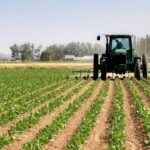 Nigeria faces significant agricultural challenges that drive up food prices. However, Olukayode Ige, a Geosciences Graduate Student in the United States conducting research on integrating Geographic Information Systems (GIS) with precision agriculture, has lent his voice to how the technology can help Nigerian farmers boost crop yields, improve sustainability, and ensure economic resilience.
Nigeria faces significant agricultural challenges that drive up food prices. However, Olukayode Ige, a Geosciences Graduate Student in the United States conducting research on integrating Geographic Information Systems (GIS) with precision agriculture, has lent his voice to how the technology can help Nigerian farmers boost crop yields, improve sustainability, and ensure economic resilience.
GIS in precision agriculture integrates spatial data with key farming metrics such as soil conditions, weather patterns, and crop growth stages. This fusion enables farmers to tailor their practices to the specific needs of their crops, enhancing efficiency and reducing wastage. For instance, through remote sensing—utilizing satellites and drones, farmers can pinpoint areas of pest infestations or nutrient deficiencies and address these issues with precision. This targeted approach minimizes the indiscriminate use of chemicals, safeguarding our ecosystems while optimizing resource use.
The economic implications are equally transformative. Variable Rate Technology (VRT), a component of precision agriculture, allows for the precise application of inputs like fertilizers and herbicides, which reduces costs and boosts profitability. Yield monitoring and predictive analytics further enhance this by enabling farmers to anticipate and respond to potential yield variations across their fields. Such insights can drive down costs and increase productivity, presenting a clear path to food security and economic stability.
On a very important note, the environmental benefits of GIS-driven precision agriculture align with global sustainability goals. By optimizing input usage and reducing the environmental footprint of farming practices, this approach supports the preservation of our natural resources and biodiversity. It offers a method of agriculture that respects the earth and can sustainably feed nations, a compelling reason for the agricultural community to embrace this technology.
Currently, for his thesis research in the United States, Ige is exploring GIS tools in precision agriculture to improve food security. As Nigeria continues to navigate the complexities of food production in a changing climate, Ige is of the opinion that the gradual adoption of GIS-driven precision agriculture in the country could be revolutionary. It offers a viable pathway to sustainable food security, ensuring that we can meet today’s needs without compromising the ability of future generations to meet their own. He, thus, beckons on the government and policymakers to prioritize funding and support for such innovative technology. The potential for a greener, more efficient, and more profitable agriculture sector is within our grasp, and it is incumbent upon both policymakers and the agricultural community to embrace this technology-driven future.











